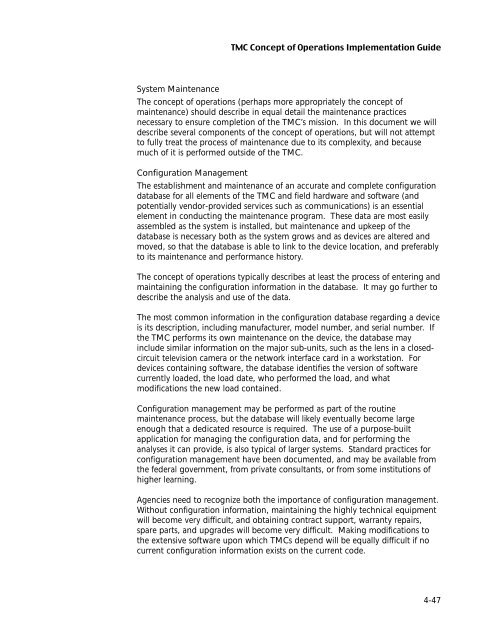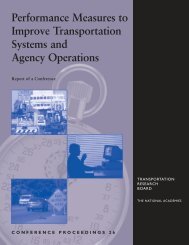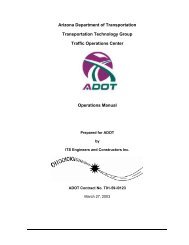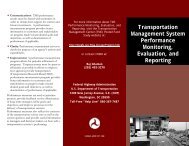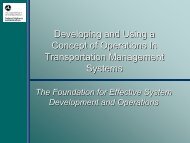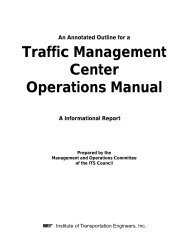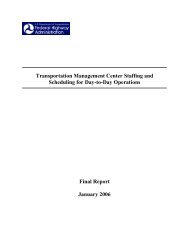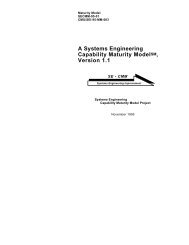Transportation Management Center Concepts of Operations
Transportation Management Center Concepts of Operations
Transportation Management Center Concepts of Operations
- No tags were found...
You also want an ePaper? Increase the reach of your titles
YUMPU automatically turns print PDFs into web optimized ePapers that Google loves.
System MaintenanceThe concept <strong>of</strong> operations (perhaps more appropriately the concept <strong>of</strong>maintenance) should describe in equal detail the maintenance practicesnecessary to ensure completion <strong>of</strong> the TMC’s mission. In this document we willdescribe several components <strong>of</strong> the concept <strong>of</strong> operations, but will not attemptto fully treat the process <strong>of</strong> maintenance due to its complexity, and becausemuch <strong>of</strong> it is performed outside <strong>of</strong> the TMC.Configuration <strong>Management</strong>The establishment and maintenance <strong>of</strong> an accurate and complete configurationdatabase for all elements <strong>of</strong> the TMC and field hardware and s<strong>of</strong>tware (andpotentially vendor-provided services such as communications) is an essentialelement in conducting the maintenance program. These data are most easilyassembled as the system is installed, but maintenance and upkeep <strong>of</strong> thedatabase is necessary both as the system grows and as devices are altered andmoved, so that the database is able to link to the device location, and preferablyto its maintenance and performance history.The concept <strong>of</strong> operations typically describes at least the process <strong>of</strong> entering andmaintaining the configuration information in the database. It may go further todescribe the analysis and use <strong>of</strong> the data.The most common information in the configuration database regarding a deviceis its description, including manufacturer, model number, and serial number. Ifthe TMC performs its own maintenance on the device, the database mayinclude similar information on the major sub-units, such as the lens in a closedcircuittelevision camera or the network interface card in a workstation. Fordevices containing s<strong>of</strong>tware, the database identifies the version <strong>of</strong> s<strong>of</strong>twarecurrently loaded, the load date, who performed the load, and whatmodifications the new load contained.Configuration management may be performed as part <strong>of</strong> the routinemaintenance process, but the database will likely eventually become largeenough that a dedicated resource is required. The use <strong>of</strong> a purpose-builtapplication for managing the configuration data, and for performing theanalyses it can provide, is also typical <strong>of</strong> larger systems. Standard practices forconfiguration management have been documented, and may be available fromthe federal government, from private consultants, or from some institutions <strong>of</strong>higher learning.Agencies need to recognize both the importance <strong>of</strong> configuration management.Without configuration information, maintaining the highly technical equipmentwill become very difficult, and obtaining contract support, warranty repairs,spare parts, and upgrades will become very difficult. Making modifications tothe extensive s<strong>of</strong>tware upon which TMCs depend will be equally difficult if nocurrent configuration information exists on the current code.4-47


